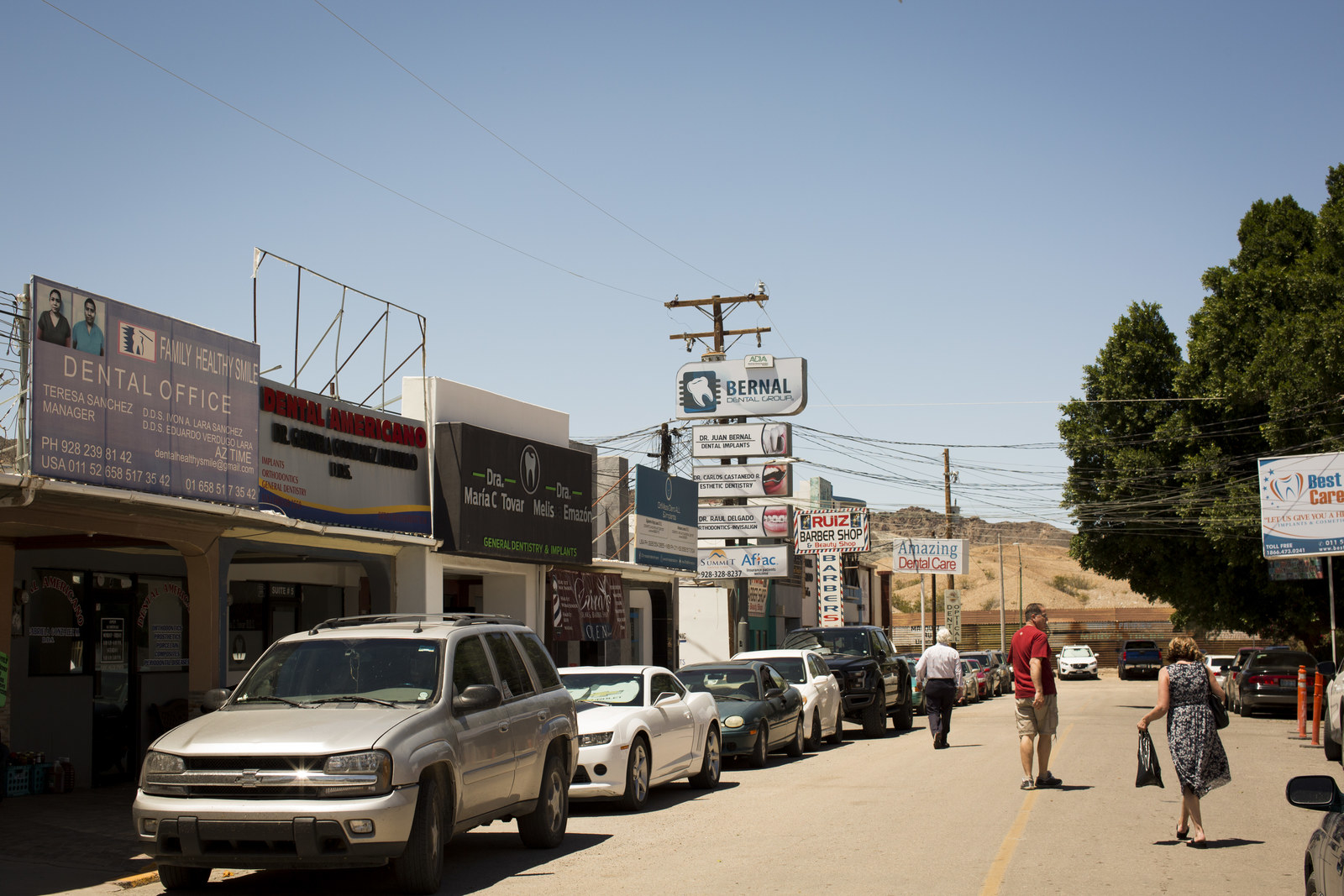LOS ALGODONES, Mexico — “Hello, my friends, are you looking for a dentist?” Pablo says, hopping off his perch on a shaded railing at the border crossing into the mid-May morning sun.
Wearing medical scrubs and a welcoming smile, Pablo introduces himself, his hand seamlessly producing a business card from his breast pocket between handshakes. “We have the best prices in town,” he says, confidently running through a litany of dental procedures his employer offers.
It’s a pitch Pablo makes dozens — perhaps hundreds — of times a day to tens of thousands of dental refugees who stream across the border at Yuma, Arizona, each year seeking the affordable dental care they only dream of back home. With an astounding 600 dentists in this town of just 6,000, competition for customers is brisk. And there is no shortage of them.
“Buddy, it’s a mine for us,” Pablo tells me.
It’s also a necessity. While Donald Trump and Congress have made repealing and replacing the Affordable Care Act one of their top legislative priorities, what’s rarely mentioned is that the US is in the midst of a dental care crisis. According to the National Association of Dental Plans, 114 million Americans don’t have dental insurance, including 46.3 million people aged 65 or older. And for those who do, the costs of dental work can still be out of reach.
Dentistry has never gotten much respect in the United States, where oral health was long seen as a cosmetic luxury rather than a necessity. Of course, that’s far from the truth — gum disease can cause serious complications with a host of life-threatening illnesses, and a rotten tooth can even kill you. It wasn’t until the 1980s that dental insurance became a standard part of workers’ compensation and that American mouths started getting the care they needed.
In the three decades since dental insurance has become common, it’s never been a serious part of any of the health care overhaul efforts Democrats or Republicans have undertaken. Obamacare expanded dental coverage requirements for children but didn’t mandate insurance for everyone. And dental plans available under the ACA cover almost nothing beyond a few X-rays and cleanings each year.
Oral health care legislation typically focuses on the uninsured; for instance, Congress is considering a bill that would help the poorest Americans gain dental care through community clinics. But providing universal dental care isn’t a priority for either party. Nor is bringing down costs. The current version of the House’s repeal-and-replace bill does not include any language aimed at boosting dental insurance rolls, and the American Dental Association has warned that changes to Medicaid and other provisions could result in children and low-income Americans losing what little coverage they now have.
Enter Molar City, the dental Shangri-la of the Mexican desert that’s doing what nobody in Washington has done: keeping American mouths healthy and happy at a fraction of the price.
Says Los Algodones Mayor Christian Camacho: “We’re helping the United States take care of the people they are not able to.”
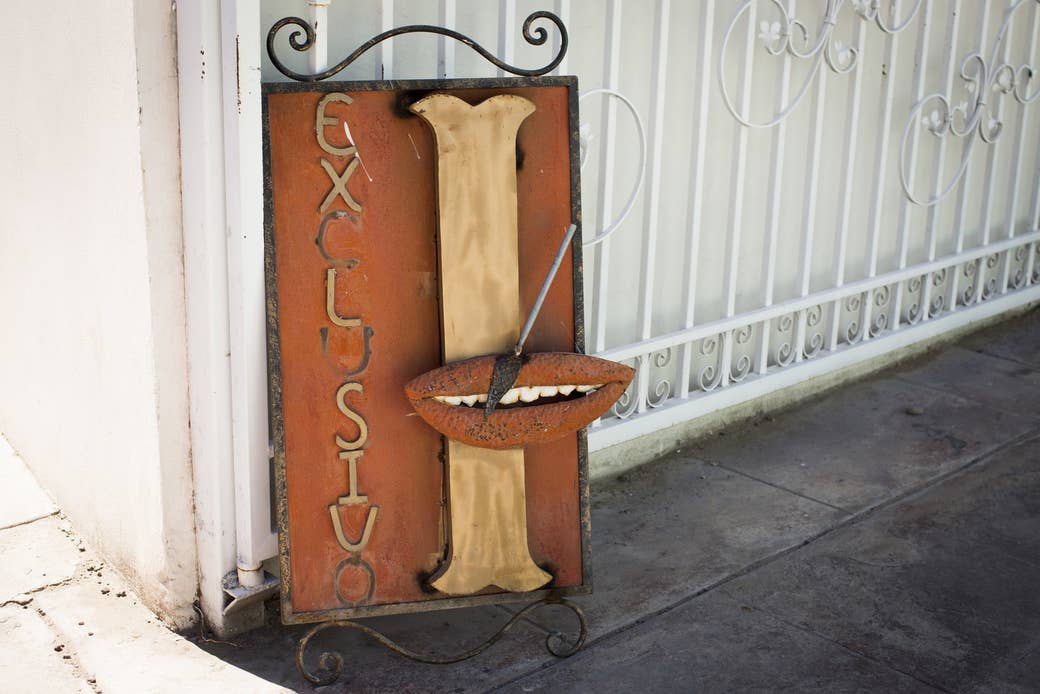
Jennifer Ure smiles sheepishly through the numbing agent as we stand on the sidewalk outside her dentist’s office. She’s just had her first round of surgery to replace three crowns on the right side of her mouth and is speaking with a lisp. The crown would have cost $600 back home in Ashland, Oregon; here, it’s $190. Her sister, Dana Gross, is here, too. Both are retired, both lack dental insurance, and both have been coming to Molar City for years.
“I’m on Medicare, and I can’t afford dental insurance,” Ure says as she starts to choke up. “I just can’t afford to pay.”
Both sisters warn that to get quality care in Molar City, you have to get recommendations from people you know and trust.
“I think it’s a little bit odd, but we can’t judge them on how they voted, so we just try to respect them.”
“You really need to do your research,” Ure, 61, tells me. “You can get some who don’t know what they’re doing, which happened to me.” Her first procedure here seven years ago didn’t go well — the implants a dentist put in fell apart soon after Ure returned to the US.
Ure, like most of the Americans I spoke with in Molar City, voted for Trump. The president’s dark warnings of Mexican rapists and gangsters coming into the US haven’t deterred his supporters from coming to Mexico for dental care.
“Trump doesn’t want to not have Mexicans coming into the United States,” Ure said matter-of-factly. “He just wants to control who’s coming into the United States legally. That’s all. Be legal about it.”
Of course, that’s not to say the Mexicans providing care don’t see the irony.
David Gil, the manager of TLC Dental, says he’s become Facebook friends with many of the patients, and “everything is Trump, Trump, Trump.” But so far, he hasn’t seen a drop-off in customers who support the president — and he hasn’t had any problems with visiting Americans. “I think when it comes to racism, people hide it … [but] why else would you vote for him?”
“I think it’s a little bit odd, but we can’t judge them on how they voted, so we just try to respect them,” says Margo Carilla, who works as a translator for a dentist in town.
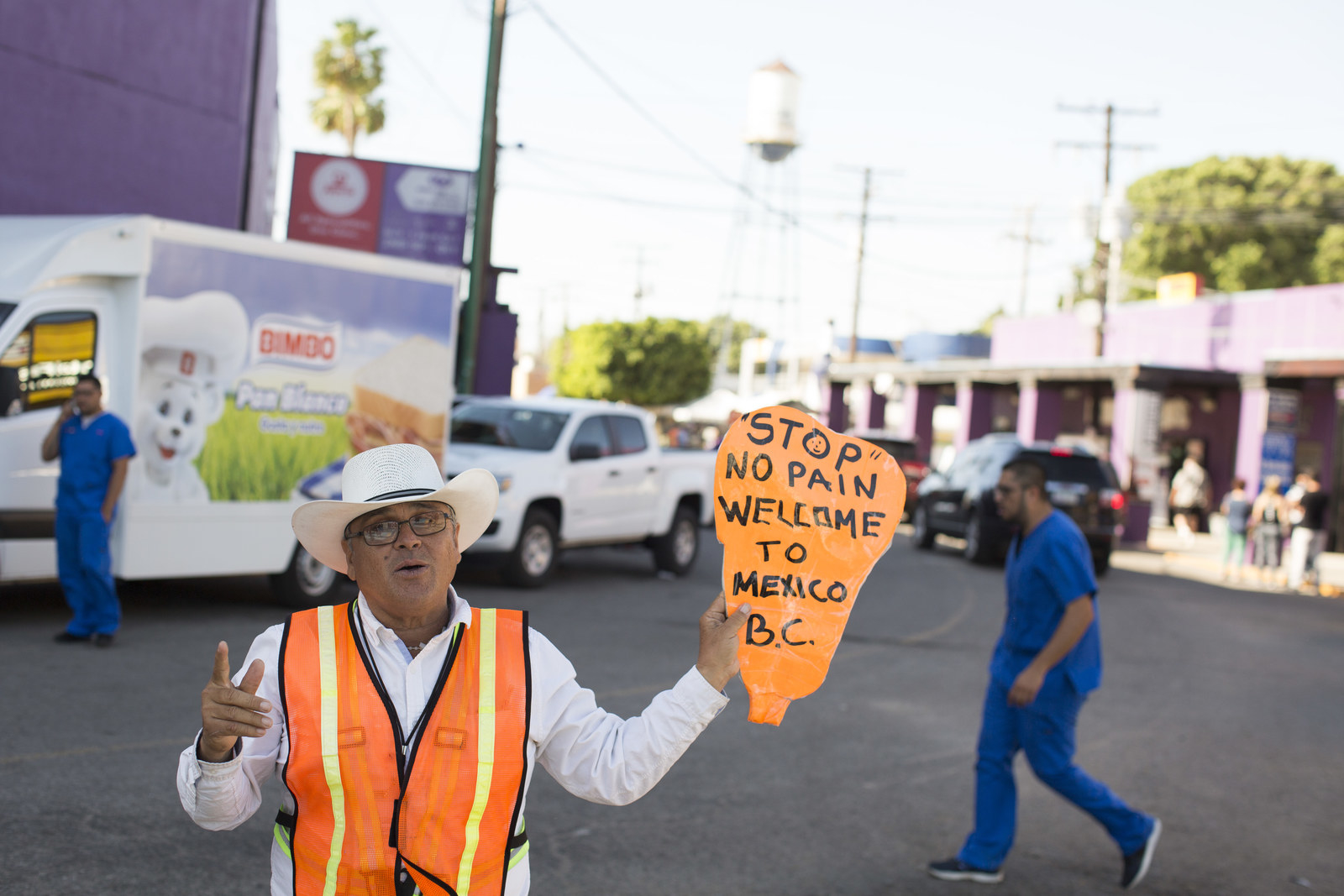
Since Americans first started coming here in the 1980s, Los Algodones has transformed itself from a small border town into a hub for dental and eye care. In addition to the dentists, 150 optometrists and 20 medical doctors work in town, with dozens of pharmacies carrying low-cost prescription medications.
Clinics routinely hire deported Mexicans who spent years speaking English in the United States to work their front desks or as barkers on the street. The state of Baja’s government also stations military personnel in town who speak English as a nod to the thousands of US and Canadian visitors.
President Trump’s promise to Make America Great Again by bringing jobs back from Mexico notwithstanding, neither the White House nor Congress seems eager to do anything about the country’s dental care crisis. And that, according to mayor Camacho, has forced Mexico to step in.
So during the mild winter months when the risk of sunstroke and heat exhaustion is low, Camacho says, about 6,000 dental refugees migrate here each day. The number drops as the desert heats up in the spring and summer, but the patient stream never stops. A large portion are US military veterans, few of whom have dental insurance or receive dental care through the Veterans Health Administration. Some are Canadian, but the overwhelming majority are US residents who flock to this safe and friendly border town that calls itself the “dental capital of the world.” Even those who have insurance face inhospitable waiting rooms and massive out-of-pocket expenses back home. In Molar City, there’s none of that.
“A lot of the people are retired and they are retired from everything, from being treated like an object. And now they deserve attention, and they deserve our service,” the 33-year-old Camacho says of the town’s decidedly older clientele and his town’s attention to their needs.
View this video on YouTube
Molar City isn’t the only place along the border where people go for dental work. At virtually every border crossing where there’s a town on the Mexican side, you’ll find dental offices. In towns like Nogales, Sonora, dental tourism was once a major economic driver. But a decade of cartel violence in Nogales and in other cities like Juarez and Tijuana has crippled their medical tourism industries.
Los Algodones, though, has continued to flourish for a number of reasons. For one thing, its proximity to Yuma makes it attractive to the snowbirds who swell the region’s population every year. Government officials have made the crossing wheelchair friendly, and there’s even talk of widening the city’s sidewalks to make it easier for elderly people to move around town.
The town isn’t a hub for cartel activity and has taken pains to avoid becoming an X-rated playground. The border closes at 10 p.m. and doesn’t reopen until 6 a.m. There’s only one hotel, and while there are a few strip clubs offering cheap buckets of beer and lap dances, there’s no obvious sign of street prostitution or drug dealing.
So, while other Mexican border towns struggle, Los Algodones is thriving, and there’s no sign of that changing, thanks to a growing population of older Americans on fixed incomes. Not even Trump’s vaunted border wall and attempts to strengthen border security appear to deter Americans migrating south for dental work.
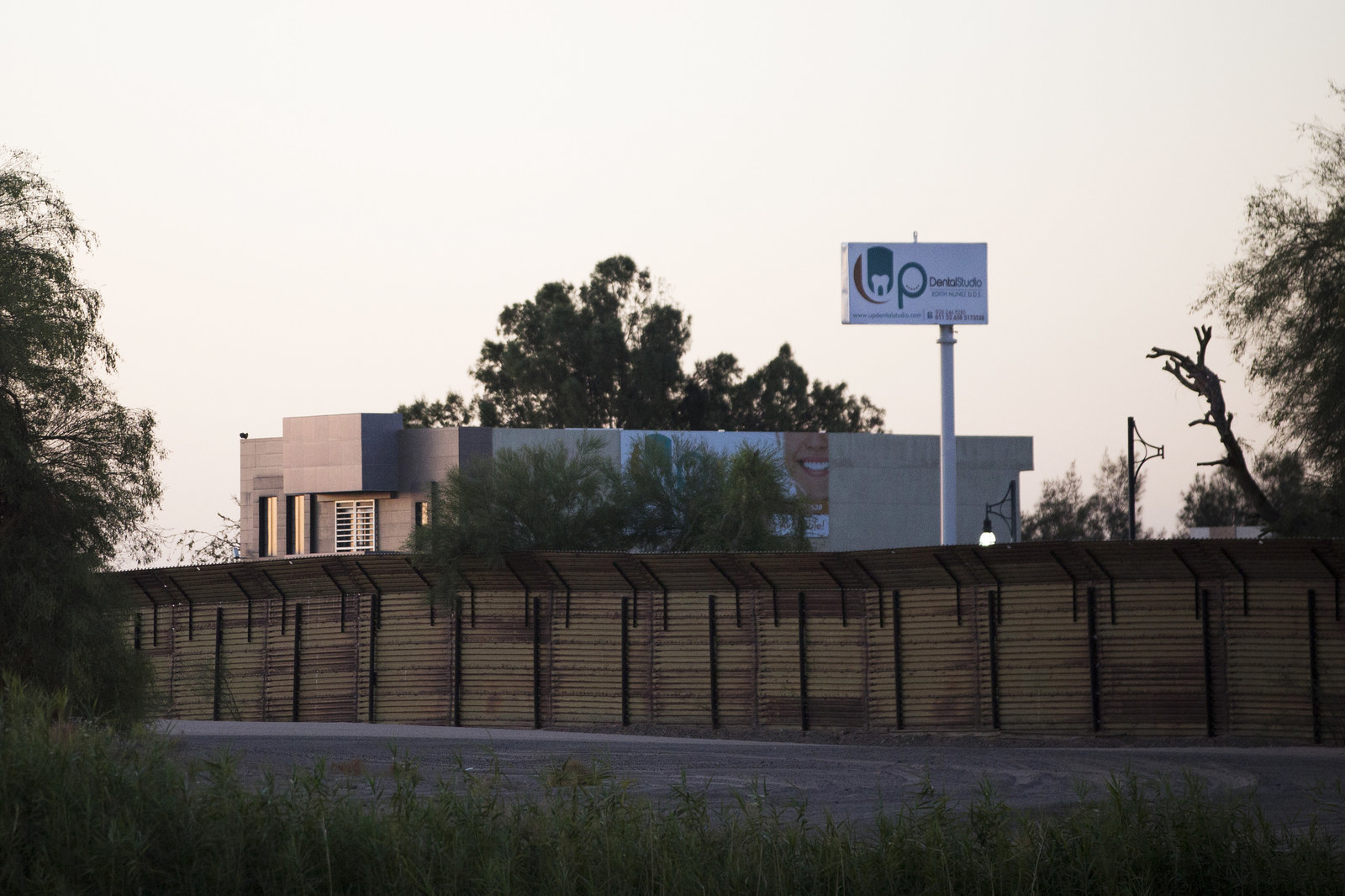
Each patient has a different story about how they found a clinic. The most common ways that Americans find Molar City dentists are:
• Seeking out border crossing guys like Pablo, taking their recommendations, and hoping for the best;
• Heading to molarcity.com, and making an appointment through the directory of dentists;
• Asking a friend for a recommendation;
• Tapping into the vast referral network that is the recreational vehicle community at the Quechan Casino across the border in Yuma.
The last route is one of the most popular and surefire ways to position yourself for the best possible care, patients say. Thousands of RV enthusiasts are avid visitors to Molar City — so much so that the nearby casino has football fields’ worth of RV parking and an hourly shuttle bus to ferry visitors between their dental visits and the slot machines. Visited by 1.7 million guests each year, the 166-room casino has become a perfect destination for dental refugees.
“You see people with gauze in their mouth…drooling at the slot machine and you know why they’re there,” says Jeff Pletcher, director of the Quechan.
“You see people with gauze in their mouth…drooling at the slot machine and you know why they’re there.”
Bernard Burks, a 67-year-old RV enthusiast and business owner from Sacramento, first came to Molar City a few years ago after hearing stories of its cheap, quality work from the RV scene.
“The RV people know about some places, so I decided to come down,” Burks says.
At first he was skeptical. As a kidney transplant patient, he has to be vigilant about the risk of infections, and the notion that dentists in Mexico were giving clients care equal to or better than in the United States seemed too good to be true.
But he needed major dental work, badly, and even with his insurance, the out-of-pocket costs made getting treatment at home almost impossible. The RV people assured him Molar City was safe.
The biggest draw?
“It’s the price,” Burks says. “It was gonna cost me $12,700 at home for three implants. And they found two root canals I needed, which would have been $1,600 for each root canal at home, plus the crowns.
“I got it all here for $4,200.”
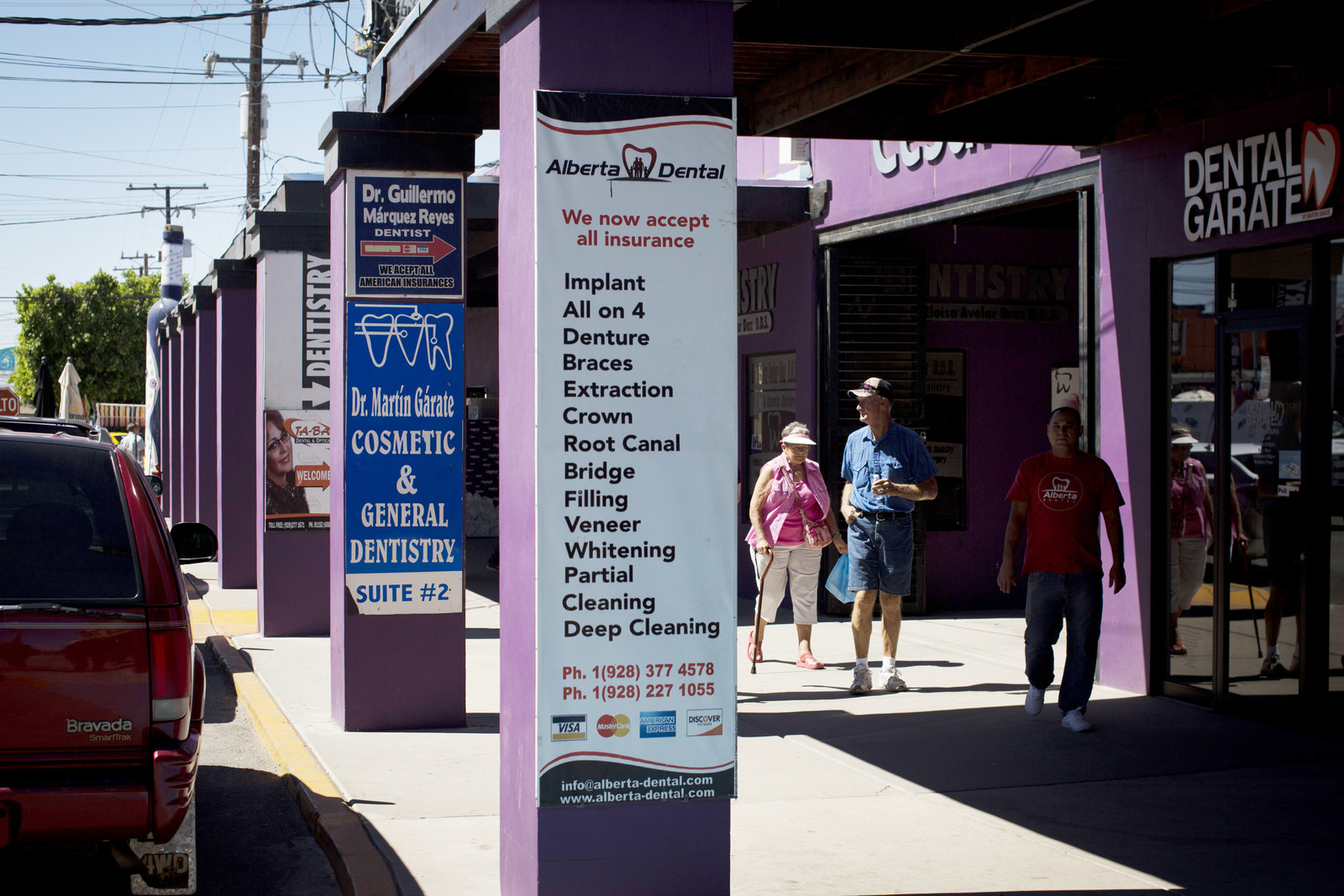
Sitting in Simply Dental’s waiting room, it’s easy to forget you’re in Mexico. The intake forms are nearly identical to ones you’d get in the States, and it has the same slightly antiseptic smell of dental clinics across the country. There are comfortable new couches and chairs, where patients sip coffee from the new Keurig in the corner. There are plenty of English-language magazines and dental brochures featuring pictures of smiling, happy, white faces. Or you can mentally prepare yourself for having sharp objects in your mouth by watching the Coldplay videos playing on the flatscreen TV.
The exam rooms are also identical to those across the border — small and slightly claustrophobic. Gleaming medical instruments line the tray next to the electronic exam chair. One difference, though, is that if you go in for a cleaning, you won’t see a hygienist or dental assistant. They don’t really exist in Molar City. Instead, you’ll get your cleaning from a dentist, like Louis Valderrama.
A graduate of the dental school at the nearby Autonomous University of Baja California, Valderrama also trained in the US and has worked in Los Algodones for five years. He says that while many patients are nervous when they first come to Molar City, the quality of work is comparable to that in the United States. “We order materials from the states … implants, for instance, we use the same brands as they use,” he says. And generally, once people have gotten work done, they come back.
And that keeps Valderrama busy. “I see approximately five patients a day. So a lot,” he says.
With so many options, many of the clinics hoping to set themselves apart offer perks like massages, aromatherapy, and customizable music playlists during procedures. But just how safe are they, and what kind of training do the dentists have?
“When everything goes great, it’s wonderful. The problem is that everything doesn’t always go that way.”
The law of averages suggests that not all of the 600-plus clinics are safe and of high quality. But many of the dentists in Molar City have either been trained in the US, like Valderrama, or have comparable degrees from accredited universities in Mexico. Part of the reason the costs are significantly lower is that Mexican dentists aren’t saddled with as much college debt as their American counterparts, in part because they begin their training earlier in college and because the government subsidizes higher education in Mexico.
Dr. Maria Howell, a Texas-based dentist and spokesperson for the American Dental Association, says the group doesn’t oppose Americans going to Molar City for work. And she’s in a position to know — more than a dozen members of her family are dentists in Mexico, and as a child she would often translate for Americans who came to her aunt’s office for care. “There are good dentists everywhere; I’m one of 13 dentists in my family, the majority of whom practice in Mexico,” she says with a laugh.
Howell, however, stresses that patients should be smart when looking to go anywhere outside of the United States for work. She recommends that they ensure the safety and quality of the dentist office, determine if there is a professional association or other mechanism through which they can make complaints if something goes wrong, and weigh the costs of follow-up care and replacements. “When everything goes great, it’s wonderful. The problem is that everything doesn’t always go that way,” she says.
Gil, the manager of TLC Dental, seems wearily amused at the notion that the quality of work in Mexico may be less than in the United States. He notes that Mexican dentists regularly attend continuing-education classes in the United States. They use state-of-the-art equipment and even buy their supplies in the US. “I’m talking everything,” he says. “The stuff you use for regular cleanings, the materials like syringes, the instruments you use. Pretty much everything.”
As for the labs in Los Algodones making your implants? Not only are they state of the art, many American dentists have begun contracting with them to make crowns and other implants for their patients in the US. “That’s why it can sometimes take two, three weeks to get your work done” in the States, he says. “You’d think if it’s cheaper over there you’d have cheaper prices.”

Gil is right about high prices: Even when Americans have insurance, it’s of little use when it comes to anything beyond routine care. For instance, according to NADP, an average plan can cost an individual close to $300 per year, and typically they are capped at $1,500 of coverage. So as long as your teeth are in good shape, it’s no big deal — most people with healthy mouths will likely spend $300 or less on biannual exams, cleanings, fluoride treatments, or other preventative measures. A stray filling or two normally costs $146 a pop, which would still be covered by most people’s deductibles.
Beyond that, the out-of-pocket costs quickly multiply: Getting a root canal and crown, for instance, costs more than $2,000 on average, and more complicated procedures like multiple implants can run into the tens of thousands of dollars.
Those costs are especially hard on people living on fixed incomes, and not just those who are reliant on Medicare. For millions of veterans, dental care is an economic luxury they simply can’t afford.
Under federal law, the Veterans Administration provides free dental care only to vets it classifies as being fully disabled or suffering from a service-related injury. Though it does provide subsidies for insurance, it’s limited. Larry Gazelka is one of those veterans. He lives in Yuma with his wife, Helen, and both travel to Molar City for dental care. A Vietnam vet, Larry suffers from the effects of Agent Orange.
“I’ve been fighting with the VA for 17 years,” he tells me. “Unless you’re 100% disabled they won’t give you any dental care.”
“I’ve been fighting with the VA for 17 years. Unless you’re 100% disabled they won’t give you any dental care.”
Bruce Turner is also a veteran. He moved to Yuma 22 years ago after he retired from the military and quickly became a regular fixture in Los Algodones. With his white beard and friendly face, Turner could be confused with Santa Claus on vacation as he walks through the small square a few blocks from the border. Turner chats up some of the souvenir vendors selling airbrushed lamps, belts, and wallets as he waits for his wife to finish shopping.
“Even though I’m retired military and have certain benefits through the military, it’s still a better deal [here],” he says. “They keep the prices down, the quality is decent. I keep coming back.”
Turner says dental care in the United States is a mess and he doesn’t know how or whether the Trump administration will find a solution. “It’s very inflated, it’s very expensive,” he says. “I don’t know how to fix it.”
I then ask Turner if he wants to let people know anything else about the dental care crisis in the United States or Molar City.
“Come to Mexico,” he says, laughing. “It’s beautiful.” ●
